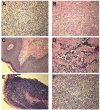Advances in pediatric rhabdomyosarcoma characterization and disease model development
- PMID: 22127592
- PMCID: PMC3922709
- DOI: 10.14670/HH-27.13
Advances in pediatric rhabdomyosarcoma characterization and disease model development
Abstract
Rhabdomyosarcoma (RMS), a form of soft tissue sarcoma, is one of the most common pediatric malignancies. A complex disease with at least three different subtypes, it is characterized by perturbations in a number of signaling pathways and genetic abnormalities. Extensive clinical studies have helped classify these tumors into high and low risk groups to facilitate different treatment regimens. Research into the etiology of the disease has helped uncover numerous potential therapeutic intervention points which can be tested on various animal models of RMS; both genetically modified models and tumor xenograft models. Taken together, there has been a marked increase in the survival rate of RMS patients but the highly invasive, metastatic forms of the disease continue to baffle researchers. This review aims to highlight and summarize some of the most important developments in characterization and in vivo model generation for RMS research, in the last few decades.
Figures
References
-
- Bartel F, Taylor AC, Taubert H, Harris LC. Novel mdm2 splice variants identified in pediatric rhabdomyosarcoma tumors and cell lines. Oncol. Res. 2001a;12:451–457. - PubMed
-
- Bartel F, Meye A, Wurl P, Kappler M, Bache M, Lautenschlager C, Grunbaum U, Schmidt H, Taubert H. Amplification of the MDM2 gene, but not expression of splice variants of MDM2 MRNA, is associated with prognosis in soft tissue sarcoma. Int. J. Cancer. 2001b;95:168–175. - PubMed
-
- Bartel F, Schulz J, Bohnke A, Blumke K, Kappler M, Bache M, Schmidt H, Wurl P, Taubert H, Hauptmann S. Significance of HDMX-S (or MDM4) mRNA splice variant overexpression and HDMX gene amplification on primary soft tissue sarcoma prognosis. Int. J. Cancer. 2005;117:469–475. - PubMed
-
- Bennicelli JL, Fredericks WJ, Wilson RB, Rauscher FJ, 3rd, Barr FG. Wild type PAX3 protein and the PAX3-FKHR fusion protein of alveolar rhabdomyosarcoma contain potent, structurally distinct transcriptional activation domains. Oncogene. 1995;11:119–130. - PubMed
Publication types
MeSH terms
Grants and funding
LinkOut - more resources
Full Text Sources

